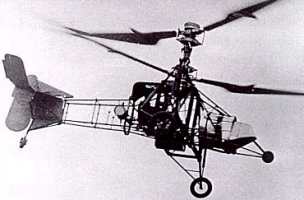
""
BREGUET
- DORAND
|
BREGUET-DORAND |


|
|
|
Luego
de la destrucción del helicóptero Breguet Richet Nº2 Bis en 1909, Louis
Breguet suspendió sus experimentos de las alas rotativas para
concentrarse en el desarrollo de los aviones. Sin embargo, hacia finales
de los años ´20 retornó a los helicópteros y en 1929-30 sacó una
patente por un sistema de estabilización. En 1931 formó el “Syndicat
d'Etudes du Gyroplane” junto a Rene Dorand como director técnico,
y comenzaron a diseñar y construir una máquina experimental conocida
como Gyroplane Laboratoire. Intentaba originalmente ser
potenciada por un motor Breguet-
Bugatti de 240 HP y la estructura consistía básicamente de tubos de
acero. Se lo equipó con un inusual tren de aterrizaje, bastante ancho,
para prevenir que la máquina volcara. La transmisión desde el gran
motor radial manejaba un par de rotores coaxiales contrarrotativos, de
dos palas cada uno bastante largas. Lo novedoso del diseño fue el uso
de un cíclico para movimientos laterales y longitudinales y un control
colectivo para los movimientos verticales. El logro del
Breguet-Dorand, fue eclipsado por la buena propaganda del Focke-Achgelis
Fw 61; este demostraba ser mejor máquina que el Breguet, pero
este tenía mejor tecnología. Se cree que el Breguet-Dorand fue
completado para noviembre de 1933. Luego de un año y medio de su primer
vuelo, el 26 de junio de 1935, la máquina piloteada por Maurice
Claisse, consiguió las siguientes perfomances: 26 de septiembre,
altura de 158 metros. 24 de noviebre de 1936, duración de 1 hr. 2 min. 5 seg; distancia de 44 Km y una velocidad de 44.692km/h. A medida que se
aproximaba la Segunda Guerra Mundial el trabajo comenzó a declinar y
lamentablemente fue destruida en 1943 durante un ataque aéreo aliado. |
|
|
|
After the destruction of the Breguet-Richet No.2bis helicopter in 1909, Louis Breguet suspended his experiments into the problems connected with rotary-winged flight in order to concentrate on the development of fixed-wing aircraft. However, towards the end of the 1920s he returned to the study of helicopters and in 1929-30 took out patents for systems for stabilising aircraft of this type while in flight. In 1931 he formed the Syndicat d'Etudes du Gyroplane, with Rene Dorand (who had joined the Breguet company in 1924) as technical director, and began the design and construction of an experimental machine known as the Gyroplane Laboratoire. Intended originally to be powered by a 240hp Breguet-Bugatti engine, it consisted basically of a steel-tube open framework supporting the engine, fuel tank, flight controls and pilot, with rear booms carrying the plywood-covered tail surfaces. An unusually wide track main undercarriage was mounted on outriggers from the central framework, with a small tailwheel and a nosewheel to prevent the machine tipping forward on landing. The transmission from the big radial engine drove a pair of co-axial, counter-rotating, 2-blade metal rotors whose blades had an aerofoil section and an unusually large diameter. One rotor shaft turned inside the other, each rotor thus cancelling out the torque created by the other. Novel features for the time were the use of a cyclic pitch control for lateral and longitudinal movement, and collective pitch for movement in the vertical plane. The achievements of the Breguet-Dorand aeroplane, eclipsed by the more widely publicised efforts of its near contemporary, the Focke-Achgelis Fw 61, have been accorded less prominence than they deserve. The later Fw 61 was demonstrably the superior machine of the two, but the advance in helicopter technology brought by the French design is most apparent when compared with the best that had gone before it. It is believed that the Breguet-Dorand aircraft was completed by November 1933: it was then little more than three years since the small Italian d'Ascanio machine had set up FAI distance, height and endurance records of 1.078km, 18m, and 8 min. 45.2 sec. respectively. Within a year and a half of its first flight on 26 June 1935 the Breguet-Dorand machine, piloted by Maurice Claisse, had eclipsed these with the following performances: 14 December 1935, distance in a closed circuit of 500m; 26 September 1936, height of 158m; 24 November 1936, endurance of 1 hr. 2 min. 5 sec; distance in a closed circuit of 44km; and speed over a straight course of 44.692km/h. Apart from advancing helicopter performance in these spheres, the Breguet-Dorand also, after a little early evidence of instability, exhibited good characteristics of controllability, and in 1937 (after a similar achievement by the Fw 61 in Germany) it made its first 'engine off' landing using autorotation. It is not certain whether the Bugatti engine was ever installed; the aircraft did most or all of its flying with the more powerful Hispano engine. It continued to carry out useful experimental work up to the outbreak of World War 2, but was destroyed in 1943 during an Allied air attack on the airfield at Villa-coublay where it was housed. K.Munson
"Helicopters And Other Rotorcraft Since 1907", 1968 |
|
|
|
Characteristics |
Information |
Characteristics |
Information |
| First
Flight Primer Vuelo |
1933 |
Engine Motor |
1 Radial |
| Seating
Capacity Plazas |
1 |
Power Potencia |
350 HP |
| Empty
Weight Peso Vacío |
1430 Kg |
Hover
Ceiling O.G.E. Estacionario O.G.E |
Fts |
| Maximum
Weight Peso Máximo |
2030 Kg |
Hover
Ceiling I.G.E. Estacionario I.G.E |
Fts |
| Vel.
Cruise Vel. crucero |
Kts |
Service
Ceiling Techo de Servicio |
Fts |
| V.N.E. V.N.E |
Kts |
Maximum
Range (Std) Alcance (Std) |
NM |
Copyright © 1999 / 2003